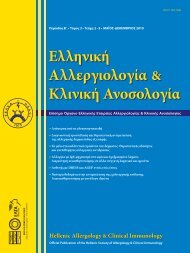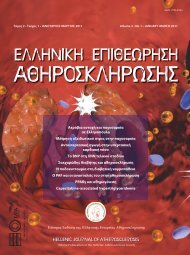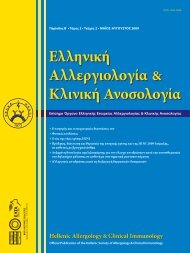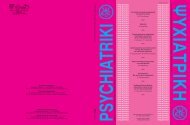ÏÏ ÏιαÏÏικη - ÎÎΤΠÎαÏÏικÎÏ ÎκδÏÏειÏ
ÏÏ ÏιαÏÏικη - ÎÎΤΠÎαÏÏικÎÏ ÎκδÏÏειÏ
ÏÏ ÏιαÏÏικη - ÎÎΤΠÎαÏÏικÎÏ ÎκδÏÏειÏ
- No tags were found...
Create successful ePaper yourself
Turn your PDF publications into a flip-book with our unique Google optimized e-Paper software.
PSYCHIATRIKI 21 (4), 2010 SEASONALITY, SUICIDALITY AND MELATONIN 327over a short term as a triggering factor for suicide,matches the mechanism of antidepressants whichinitiate a pronounced motivation into the mood beforethey improve the whole spectrum of depressivesymptoms. It is possible thereby, that changes in theweather increase the risk of suicide mainly in individualswith specific vulnerability; even though there isno identification of a “suicide-gene”, certain genesmight interact with each other so as to predisposeto suicidal behavior under the influential role of thephotoperiodic message.The “Low melatonin syndrome”A described hypothetical model for a subgroup ofdepressed individuals involves low nocturnal melatoninlevels along with: (a) abnormal dexamethasonesuppression test, (b) less pronounced periodic alterationsin symptoms, and (c) abnormal 24-h rhythm ofcortisol.Neither the SAD patients, nor the subgroup ofpatients with Low Melatonin Syndrome (LMS) followany specific suicide seasonal pattern. Howeversymptoms correlated with the latter, like anaedoniaand lassitude may incline towards suicidal thoughts;moreover, lower levels of pineal melatonin contentwere found in suicide victims. Some depressed patientssuffering from lassitude and profound sadnesshad lower melatonin levels, albeit in this study havebeen reported higher melatonin maximum levels inparticipants with suicide attempts than ones with nosuicide attempt. 59Seasonality of melatonin levels andinteraction between 5-HT and melatoninIn a sample of 32 depressed outpatients, Carvalhoand colleagues noted alterations in the levels ofa urinary metabolite of melatonin solely in thosewith severe symptoms. 38 The analyzed participantswere drug-free, thus it was possible to exclude theconfounding process of the cytochrome inhibitionby several drugs which may alter the secretion amplitudeof melatonin. Significant peak of suicides,particularly for the age group over 45, have beenobserved in the morning by other investigators. Still,various limitations remain, such as the factor of abnormalsynchronization to the duration of photoperiodin patients who, due to their melancholic symptoms,spend less time outdoors. To make things morecomplicated, the day-length variations over differentseasons of the year may not represent the sameamount of the light exposure for different individualsand populations. Given that illuminance of 60 luxsuppresses melatonin secretion, its onset seems todepend exclusively upon the timing of sleep, as faras individuals in modern life are concerned. Besides,artificial light contains less blue than natural one;considering previous observations that the spectralsensitivity for melatonin regulation is greater for theblue light, it becomes obvious that the time spendingindoors with lights open contributes in a complicated,plus worthy of further understanding, wayto the modulation of the circadian characteristics ofbehavior. 60–63Arendt et al 64 noted that the annual variations ofserum melatonin tend towards an inverse patternwith the levels of platelet 5-HT. Moreover, the 5-HThypothalamic content (probably representing aprecursor for the production rate of melatonin) wasfound 180° out of phase with melatonin content.Administration of melatonin increases serotonin levelsin brain regions and 5-HIAA in cerebrospinal fluid.Numerous publications described low melatoninlevels in spring and suggested a close interconnectionbetween fluctuations of the two indoleamineswith a nadir in 5-HT levels in winter confirming theinverse pattern. 65–68 Among the former, one mayfind enough evidence to hypothesize a bidirectionalinteraction and data contributing to interpretationsfor seasonal phenomena, such as affective disorder,extraordinary impulsivity and suicidal acts.ConclusionThe annual variation in suicide has been inverselyrelated to the annual pattern of melatonin with aspring-peak in suicides and a spring-nadir in melatoninlevels, along with seasonal changes in closelyrelated neurotransmitter systems, mainly those ofserotonin. No profound relationship has emergedamong meteorological conditions and tendencyto suicidal behavior. Socio-epidemiological factorsneed to be taken into account, while the way theintrinsic circadian system interacts with psychiatricconditions remains uncertain. 69,70 Further researchregarding the aetiopathogenesis of suicide in relationto sunlight exposure and rhythmicity of melatoninactivity, might lead to an explanatory modelfor the seasonal distribution of suicide.













